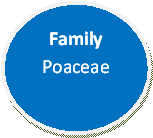Where Do I Belong?
 Multicellular, Linear Chromosomes, Sexual Reproduction, Membrane Bound
Organelles, Contains a Nucleus
Multicellular, Linear Chromosomes, Sexual Reproduction, Membrane Bound
Organelles, Contains a Nucleus

Alternation of Generations, Photosynthetic, Common Freshwater Algal
Ancestor, Cell Walls Composed of Cellulose

Flowering plants, Have True Roots, Stems & Seeds, Dominate Sporophyte
Generation, Ovule Develops into Seed, Ovary Develops into Fruit
 Single Cotyledon, Parallel Veined Leaves, Floral Parts Seen Typically in
Sets of 3, 4 or 5.
Single Cotyledon, Parallel Veined Leaves, Floral Parts Seen Typically in
Sets of 3, 4 or 5.

Wind or Self-Pollinated Flowers, Ovary Bears a Single Ovule
 "True Grasses", Hollow Stems,
Fibrous Root Systems, Annual & Perennial Species, Flower
Usually Bisexual,
"True Grasses", Hollow Stems,
Fibrous Root Systems, Annual & Perennial Species, Flower
Usually Bisexual,
Fruit Circular in Cross Section
 High Concentrations of Sucrose in the Internodes of the Stem,
Poor
Disease Resistance, Initially Rapid Stem
High Concentrations of Sucrose in the Internodes of the Stem,
Poor
Disease Resistance, Initially Rapid Stem
Growth
 Perennial, White Flower, Dense Foliage, High Anaerobic Tolerance, High
Drought Tolerance, Propagated by: Seeds,Sprigs, Tubers, or Sod
Perennial, White Flower, Dense Foliage, High Anaerobic Tolerance, High
Drought Tolerance, Propagated by: Seeds,Sprigs, Tubers, or Sod
Now that we know where sugar cane fits, lets discover what it's
related to by looking at the
Phylogenentic Tree.
More information on the classification of sugar cane can be
found the
USDA plant database.